- Home
- Gary Vaynerchuk
The Thank You Economy Page 11
The Thank You Economy Read online
Page 11
So the answer to the question of whether this campaign worked depends on whom you ask. Ninety-nine percent of the market would probably say that it was a social media win—it caused buzz, it resulted in a fantastic amount of earned media,* and ultimately, sales did spike. Ninety-nine percent of market, however, doesn’t realize that we’re in a Thank You Economy, and it is using old media standards to tally up its victories. So yes, the campaign did win—it won the same way a traditional commercial wins. But it could have won more if Old Spice had seen the initiative through.
Old Spice thought when the campaign was done that they were done. Huge mistake. A social media campaign in the Thank You Economy is never done! The Thank You Economy rewards marathon runners, not sprinters. All P&G needed to do was sprinkle a little bit more pixie dust by humanizing their business and ensuring long-term relationships with their customers, but they gave up. In doing so, they turned what had all the markings of a superb social media campaign into a one-shot tactic.
Old Spice saw a major spike in sales and brand awareness, but there are plenty of brands that have done great marketing, spiked for a while, and then disappeared off the consumer radar. The brand had an opportunity to continue the conversation with all of those people who connected with them, and they squandered it. They left their customers behind, limiting the full impact the campaign could have had on the brand. I’m sure there are more than a few people who were miffed when they could no longer interact with it. Worse, though, are the many, many more who simply forgot about the brand, and about how much fun they had interacting with it. It will cost Old Spice a lot to reengage those people.
I’m in utter shock. On one hand, I am devastated to see this turn of events and want to call Old Spice and beg them to let me help get them back on track; on the other hand, they’ve given me a great opportunity to show you how a brand can sabotage a great social media campaign.
I was going to buy another stick of Old Spice when I used up my first one, but the wind has been knocked out of my sails. I mean, what their silence on Twitter tells me is that they’re through with me. They’re glad that I, and thousands of others, spent our money with them, and now they’re just going to sit back on their laurels, enjoy the spike in revenue, and move on to a new campaign.
I hope one of Old Spice’s competitors is reading this right now. Old Spice had a huge chance to turn 120,000 strangers into acquaintances, and maybe even friends, but as of this writing P&G made it pretty clear their interest in their customers goes only skin deep. Now is the competitor’s chance to show people how a brand really cares about its current customers, and the ones it would like to know.
* * *
When I started Wine Library TV, I was the only game in town, and I built a pretty loyal following by constantly engaging and conversing. Later, I watched some competitors try spamming or otherwise reaching out to my customers and fans, trying to poach my business. They failed, because I already had my customers’ hearts. As my business grew, however, and it became harder to provide the same level of one-on-one engagement my fans were used to, I could see on Twitter that some relationships were starting to form between certain of my customers and my competitors. When I stopped working as hard on my relationships with those people, a new guy was able to come in and steal them from me. It’s no different from the married woman who comes home from having a fun night of after-work drinks with a colleague to find her husband so immersed in his video game he can’t even break away to ask her about her day. Is it any wonder that she eventually falls for the other guy? As it goes in life, so it goes in business. You have to keep working at every relationship in your life, whether personal or professional.
* * *
Maybe I should give Old Spice the benefit of the doubt; it’s possible they’ll have gotten back in the trenches between now and the time you read this book. I hope so. Even if they do, though, they will have lost out on a ton of potential long-term business, and will have to work much harder to regain the momentum they once had.
CHAPTER SEVEN
Intent: Quality versus Quantity
In Crush It!, I talked a lot about my belief that embracing your DNA, zeroing in on your passion, and living that passion day in and day out were the keys to creating a fulfilling, happy personal and professional life. Since then, I’ve realized that there’s something else that counts. In fact, it may be the single biggest differentiator in this new economy: good intent. I strongly believe that if your intentions are good, it shows, and it draws people to you. Good intentions create a pull. Now, you can probably think of many examples of individuals who were able to fake good intentions to get what they wanted. But I think that the Thank You Economy, which has brought us platforms like Facebook and Twitter that emphasize transparency and immediacy, has given consumers better tools to spot and expose a company’s or brand’s hidden agendas and bad intentions, as well as tools to recognize, and reward, good ones.
If you’ve ever considered embarking on a social media campaign, or even tried an initiative or two, what was your intent? Was your goal to get someone to click through or click the “Like” button? Or was it to build your online identity and foster a connection between yourself and the consumer? If your answer is the former, you’ve just hit upon the reason why most campaigns fail to meet their potential.
“What’s wrong with getting people to click through?” you might ask. “What’s wrong with using social media to drive traffic to my site or store?” Nothing. But if the only reason you’re on YouTube, Tumblr, Twitter, or any other vibrant online community, is because you’re trying to attract more followers and fans than the other guy so you can market your message to that user base, you’re playing the wrong game and you’re going to lose. If your view of social media is so tunnel-visioned that all you care about are the number of fans or retweets or views you’re garnering, you’re missing the whole point. Success in social media, and business in general, in the Thank You Economy will always have to be measured with an eye toward both quality and quantity. You can throw meaningless tactics around to increase your numbers, but even if they work and your online numbers look impressive, you won’t have gained anything of true value because you didn’t put anything of true value out there. All the numbers prove is that you’ve made contacts, not connections. A successful social media campaign is one that plays close to the emotional center; the farther away you stand from that center, the farther away your customers are going to stand, as well. Their value will therefore be worth less in the long run than it would have been had you engaged with them in such a way as to make them want to come close. These core principles that factor into the lifetime value of a customer are cornerstones of the Thank You Economy.
Social media works best when you evoke an emotion in the people to whom you’re reaching out. It pulls. When you place a traditional ad, whether it’s on TV, radio, print, billboard, or banner, you’re spending a lot of money to hold on to the microphone and say your piece over and over and over again. You’re pushing your way into the consumer’s consciousness. Some people try to use social media the same way, by pushing sales pitches and gimmicks. Their efforts might get some brief attention, but the message will fade and it certainly won’t have long-term value; it’s just not worth thinking about. If you’re going to launch a campaign, it has to be one that evokes an emotion—positive or negative—so that people feel compelled to share. Give them something to talk about, unleash the power of word of mouth, and allow them to pull you into their consciousness. Letting the consumers decide for themselves that they really want to know you, versus persuading them that they should, can make a very big difference in the kind of relationship that ensues. It’s like when parents decide they’ve found the perfect girl for their son. He’s not going to ask the girl out if they badger him to death, and even if he did, the poor girl probably won’t stand a chance because he’s only doing it to get his parents off his back. But, if they have a party, and they make sure the girl is there, and they ar
e right about this being a perfect match, those two kids are probably going to find each other. Then they can go out on one of those perfect dates where the conversation never stops. Use social media campaigns to create an opportunity for engagement, not to force it.
Day-to-Day Intent
The same intent that fuels any successful social media campaign also has to be behind the day-to-day engagement a brand pursues via social networking sites. Your intent should be twofold: water as many plants as possible, and put out every fire. When you’re tending to online relationships, every engagement should be answered with emotion, from the heart. You may as well get good at it now, because very soon it will be an extremely important part of your marketing mix, and quite possibly the only approach that actually works. That does not mean you have to write a sappy love letter to everyone who praises your brand. Emotion doesn’t have to be wordy; it just has to be authentic.
One company that has been getting their game down is Quirky, Inc., a website for inventors. When they first launched their Twitter stream, they used it to reach out to their community and attract newcomers to their site, but their one-way feed made it look as though all they cared about was pushing their product. How was that going to bring anyone to the emotional center?
Then Quirky started posting content intended to pull people in, not push their message out. They turned every outreach or mention they saw into a conversation, engaging with people who wanted to engage with them. The difference is amazing.
Since changing their approach, Quirky says, “We’ve had tons of (often amusing) back-and-forths on the Twitter machine on everything from product feedback to favorite Simpsons episodes. Now, we’re not letting any tweet go un-tweeted back!” For Quirky, a company built on crowdsourcing product ideas, increased product feedback is an important business function. In addition, the increased chatter optimizes their overall data collection process. Customers are going to talk about a business without that business’s involvement, but when a business interacts with its customers, the extra discussions that ensue can reveal valuable data. Any company should be able to see how it could benefit from that kind of engagement.
When doing damage control, or putting out fires, you’ve got to loosen your grip and share the microphone, and listen, then respond appropriately, and then listen again. You have to listen even when you really don’t feel like listening anymore. Think about it this way—no issue has ever been resolved when someone left the room in the middle of the conversation.
One thing that’s daunting to many about social media is that it requires you to throw away the script. The rules of engagement force you, or the person to whom you have entrusted your brand’s voice, to improvise, and be willing to go wherever the consumer leads you. That’s a scary proposition for a lot of businesses and brands, and I can understand why. Corporate leaders are obsessed with staying on message, as they should be, and their scripts are carefully crafted to make sure that message is repeated no matter what situation arises. The problem is, of course, that they can’t possibly foresee the details of every possible customer interaction, a reality that is becoming increasingly problematic for them as social media increases the frequency with which consumers want to speak directly to brands.
* * *
Some companies want to be able to say they have a social media presence, but they’re so frightened of the legal issues that could arise with one stray, unfiltered post that they demand that any company Twitter feeds or Facebook updates be vetted. In some organizations, getting legal approval for a tweet can take twelve to thirty-six hours. Are you kidding me? By the time that vetted post finally makes it to the customer, the conversation and the relationship have sailed.
* * *
Customers are unpredictable, and forcing a script upon the brand reps they’re turning to for help is like handing a firefighter a single bucket of water, instead of a hose connected to a hydrant, as he tries to save a burning building. In fact, a formal, safe script only adds fuel to the fire once customers realize that the responses they’re getting have no context for the current situation. The most passionate customer service rep in the world couldn’t inject soul into a canned response written two years, or even two months, earlier.
You have to learn to trust the people you hire to do this job (or do a better job of hiring people you can trust). You have to let your reps be themselves. Don’t force them to channel your lawyers or your board members or your PR department (or worse, hire your PR department to engage for you). Otherwise, as soon as the conversation goes off script, they’ll be lost. And when that happens, you’ll lose your customer, too.
* * *
Ninety-five percent of the worst social media engagement I’ve seen was produced by PR companies that were hired to manage a brand’s profiles, pages, or blogs. Please, companies, stop hiring PR firms to do your community management. PR is in the push business; they send out press releases and book appearances and work B2B. They’re used to talking with editors, writers, and producers, not the public. They have no idea what’s going on in the trenches, and they’re awkward and shaky when they try to go there. The only reason PR claims they can do it is because they see which way the wind is blowing, and it’s not toward them. They’ll say anything to avoid losing your business. The ad agencies do a better job than the PR companies, because they are in the business of thinking about what the consumer wants, but ideally, try to hire people internally for this job. Select the employees who know your business well, and care about it as much as you do, and can demonstrate quick, creative thinking, flexibility, and compassion. Those are the people you want representing your brand to the masses. If you don’t feel as though you have the knowledge in-house, hire a company to get the ball rolling and train your staff, then hand the reins off to your team.
* * *
You think the guy who holds the record for the longest customer service call at Zappos—five hours!—was working with a script? The script is meant to push the message out. Your intent should be to pull the heartstrings, but not in a manipulative way. Simply talk, and listen. Talk. Listen. By creating the expectation that you’ll listen, you create more engagement, which increases virality, and word of mouth, and a sense of connection to your brand. You may not be able to quantify the effects of connection (yet), but I promise you it plays out when consumers are reaching into their pockets. A sense of connection is why people show up at my book signings, and why I feel a bond with my fans even though I may never meet them in person. It’s why someone who wasn’t thinking about snacks spots a pack of Skittles, remembers the exchange she had with the brand a few days ago, and throws two packs into her cart.
Push tactics aren’t all bad; they can be effective when used in moderation. But the intent of push tactics must be to create a pull opportunity, for that’s what creates emotional bonds between consumers and brands. And sometimes, if you use some imagination and pull hard enough, you can create something really special.
CHAPTER EIGHT
Shock and Awe
What if you’re actually doing a good job of caring people’s socks off? You’ve got the rules of engagement down pat, so to speak. You’re responding to comments, tweets, and reviews wherever you spot them, and inviting people to share their thoughts and ideas with you. You’re seeking opportunities to join or create conversations around topics and niches that are well within the general scope of your product or service, as well as those that may be only tangential to it. You’re solving people’s problems and thanking them when they acknowledge that you’ve done something right. You’re even thanking them when they tell you that you’ve done something wrong. You’re initiating smart, thoughtful, creative tactics that have good short-term payoff, and this will also pay off in the long run because their intent is to strengthen the emotional connection already in play thanks to all your other efforts. Always you’re being yourself, minding your manners, speaking from the heart, and thinking creatively. What more could you possibly do?
A lot.
If you ask phenoms to share the secret to their success, many will often reply that it was paying attention to the little things. The athlete got up early every morning for an extra hour of training; the high-end restaurateur made families feel welcome with early-bird hours and adult-quality kid food served in charming frog-shaped dishes; the car wash owner provided Wi-Fi. What’s remarkable about the little things is that the positive impact they have on a person’s performance or a customer usually far outweighs the effort or cost it takes to implement them.

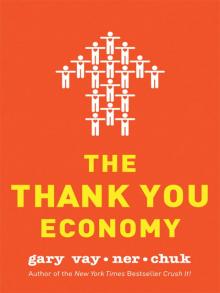 The Thank You Economy
The Thank You Economy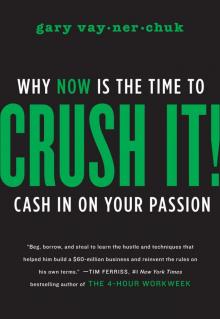 Crush It!
Crush It!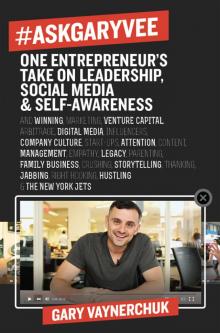 #AskGaryVee
#AskGaryVee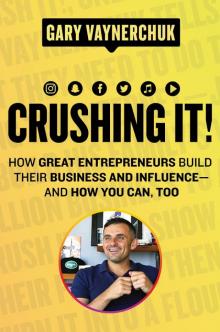 Crushing It! EPB
Crushing It! EPB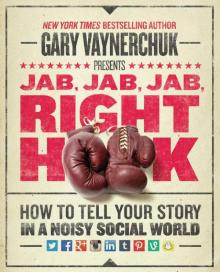 Jab, Jab, Jab, Right Hook
Jab, Jab, Jab, Right Hook